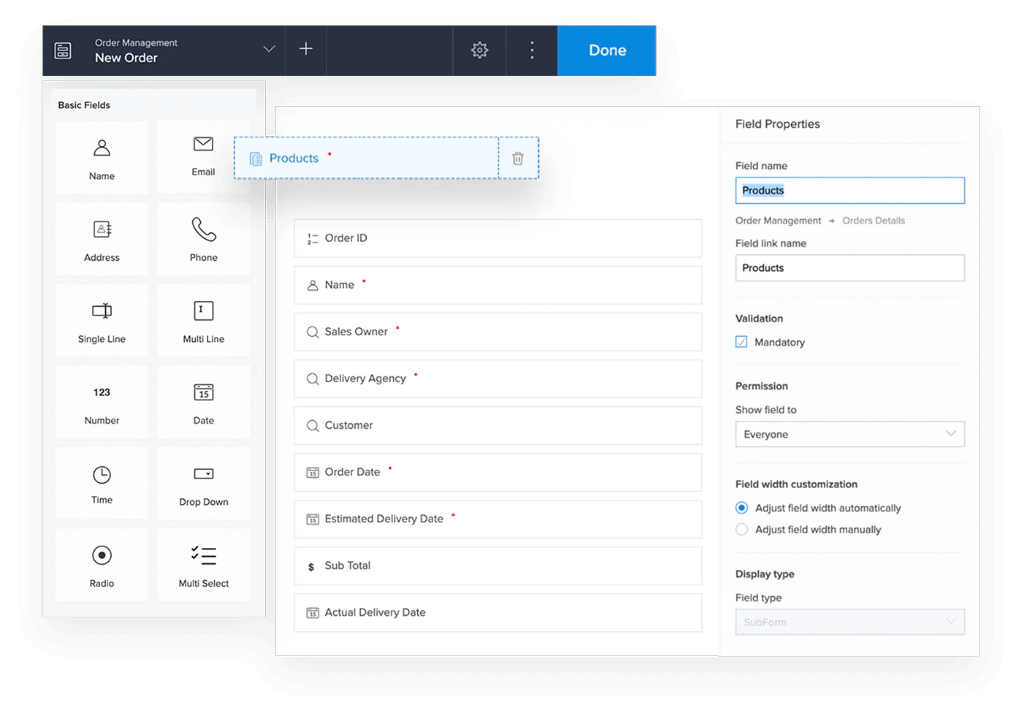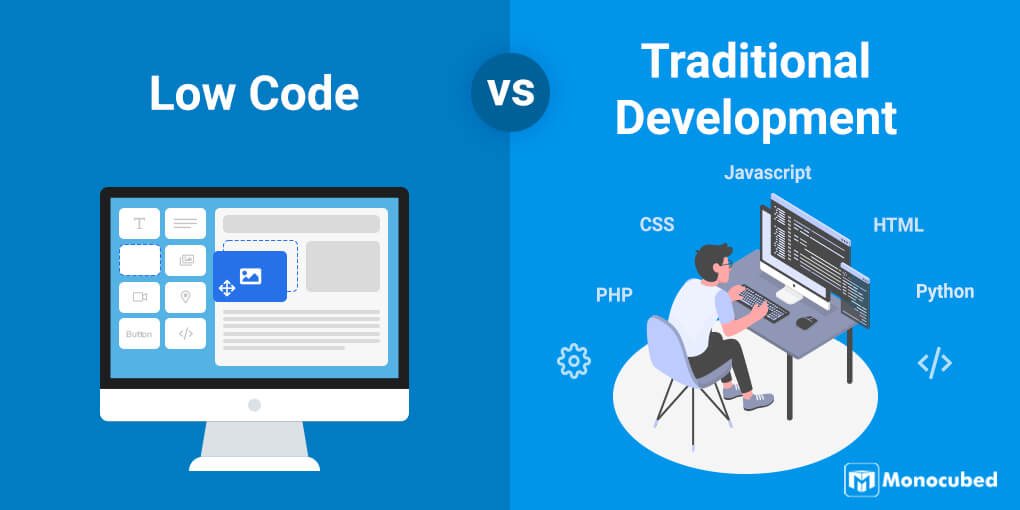Free News For Choosing Low-Code Platform Info
Wiki Article
The Benefits Of Low-Code Development For Non-Developers In Terms Accessibility
Low-code applications greatly improve accessibility for non-developers. They are often referred to as "citizen developers," because of a variety of key aspects: Intuitive visual interfaces:
Drag-anddrop Builders: Lowcode platform include drag-anddrop interfaces to allow nondevelopers to visually create applications without the need for code. This makes it simpler for people who don't have technical background to participate in the development process.
WYSIWYG Editors: "What You See Is What You Get" editors let users design interfaces and workflows in the same way as the actual product, which makes it much easier to use and understand.
Simplified Design of Workflow Logic and Workflow:
Visual Workflow Modeling: Users may create business processes and application logic by using visual flowcharts or models that are easier to understand than conventional coding techniques.
Low-code platforms usually come with pre-built logic components (e.g., conditions loops, statements) which eliminate the need for complicated programming.
Reusable components and templates:
Library of Pre-built Templates: Numerous low-code platforms have templates for common application types that allow non-programmers to begin from a solid base and customize as needed.
Reusable modules and widgets: The creation of web pages is made simpler by using reusable components as well as modules. This reduces the need for deep technical knowledge.
Guided Development Tutorials and Guided Development:
Step-by-Step Instructions: Platforms typically provide a development path with guidance or online tutorials screen-based instructions that can assist users who aren't developers to create applications.
Interactive Tutorials Interactive tutorials are hands-on and interactive, which help users to learn through doing. This increases their confidence in the platform.
Integration with existing tools:
Integration seamless: Low-code platforms have been developed to integrate seamlessly with existing business systems and tools (e.g. ERP, CRM) making it possible for non-developers to develop applications in their existing workflows.
APIs and Connectors: APIs integrated into connectors and APIs enable users and non-developers to connect applications to external services, without the need for complex coding.
Collaboration Features:
Team Collaboration Features, like real time collaboration and shared workspaces, enable non-developers and professionals to work together effectively.
Role Based Access Control You can assign non-developers specific roles that correspond to the appropriate access level so that they can be part of the development process while not compromising on security or functionality.
Automated testing and debugging:
Low-code platforms are often equipped with debugging and testing software that can automatize these procedures. This makes it much easier for non developers to verify their applications work correctly.
Error Highlighting - If issues occur, the system highlights problems and provides solutions. It also guides users through troubleshooting.
The main benefit of developing applications using low-code in terms of accessibility for non-developers lies in its ability to democratize the development process. Platforms with low-code enable business users by providing them with intuitive, visual and guided tools. They can then actively take part in the process of developing and maintaining applications. Follow the most popular look at this about Low-code Platform for application development for site examples including mobile app development platforms, paas service, mobile development platforms, low code platforms, mobile app development platforms, multiplatform mobile app development, cloud software applications, rad application development, rad development, push notifications and more.

Advantages Of Low-Code Application Development In Terms Of Flexibility And Scalability
Low-code applications offer several advantages in terms of scalability. They are scalable and flexible, and they can be adapted to new requirements. These are the major benefits: Rapid Scaling:
Cloud-Based Platforms: A large number of platforms that are low-code-friendly are cloud-based. They let applications scale smoothly with the cloud infrastructure. This allows businesses handle increased load without worrying about managing servers.
Auto-Scaling: The auto-scaling feature will automatically adjust the resources according to the demand. This will ensure the same performance even during peak hours, without any manual intervention.
Flexible Architecture:
Modular design: Low-code platforms are a great way to promote modular applications. This allows components to be developed independently as well as tested, sized or even resized. This is a fantastic method to improve flexibility. It can also be used to upgrade and expand components of an application without having the entire application affected.
Microservices Integration : Supporting microservices, applications can be built using loosely-coupled services to improve the flexibility and scalability.
Customizable Options:
Extensibility Low-code platforms typically allow custom coding and scripting. This allows developers to enhance the capabilities of their applications beyond the capabilities that are available in the box. This allows for unique business needs to be met with no limitations.
Third-Party Integrations: Businesses can add additional functionality and features into their apps through APIs and third-party services.
Agile Development Deployment, Agile Development and Agile Development:
Continuous Delivery and Deployment Low-code platform support agile methodologies enabling continuous integration, continuous delivery (CI/CD). This enables rapid deployment of updates and the introduction of new features, allowing applications to grow rapidly in response to user feedback and changes in the market.
Iterative Design: Because low-code is an iterative process the applications can be gradually improved and enlarged. This permits controlled growth and reduces the risks of large-scale changes.
Resource Optimization
Efficiency in Resource Management: Low-code platforms allow you to optimize the usage of resources through providing instruments for monitoring and controlling application performance. This ensures that resources are being used efficiently. They can also be scaled-up or reduced according to actual needs.
Load Balance: This function lets the application handle the load of heavy traffic by spreading workloads among multiple servers. This also ensures the performance remains consistent.
Global Reach:
Multi-Region: Low-code platform deployments are typically accessible across multiple countries and allow businesses to provide high-quality, low-latency services to all users. This is essential when it comes to applications that target a global audience.
Localization Support for Localization built in, which allows for applications to be easily adaptable to various languages or regional needs. This allows for greater flexibility in different markets.
Maintenance and Updates
Simple Maintenance: The aesthetic and modular nature of low-code software simplify maintenance tasks making it possible for updates and bug fixes to be implemented quickly without lengthy downtime.
Version Control: Integrated version control systems allow for the safe deployment of updates and rollbacks. Older versions can be restored in the event that they're needed.
Cost Efficiency:
Low-code platforms cut down on development costs because they eliminate the need for extensive code. They allow developers to expand applications without significant expenditure or effort.
Pay-As-You-Go Models - A lot of low-code platforms offer flexible pricing structures, like pay-as-you-go, which aligns costs with the actual usage, growth, as well as financial flexibility.
The ability to scale low-code applications permits businesses to create robust, adaptable, scalable, and robust applications. These platforms allow quick adjustments to changing demand, efficient resource utilization, and continual improvement. Applications can expand and adapt to the changing needs of business. View the best her response for Enterprise application development with Low-code Platform for blog recommendations including cross platform mobile development, cross platform app dev, paas service, application modernization software, app modernisation, build a docker container, rapid action development, low code platforms, azure sql databases, develop cross platform mobile app and more.

Advantages Of Low Code Application Development In Terms Of Limitations And Customization
The low-code method is a balanced method that allows for extensive customization, and also addresses the issues. These are the main advantages: Handling the limitations
The Challenge of Overcoming Complexity Barriers
Low-code development platforms are easier to use since they offer ready-made components, templates, as well as various other tools. They also allow for rapid deployment of even the most complex applications.
Many platforms have guided workflows, which help developers navigate their way through the complex procedures. They minimize the risk of error and maintain consistency.
Scalability Solutions
Built-in Scalability: Low code platforms have many options that enable an architectural design that is scalable, allowing applications to take on a greater demand without requiring significant changes.
Performance Monitoring: Integrating instruments for monitoring performance as well as tuning, optimization and tuning can help applications scale efficiently.
Security and Compliance
Integrated security features Low-code platform include built-in measures for security, such as encryption. Access control based on role and automated compliance check address the most frequent security issues.
Platforms frequently update their security and compliance measures to ensure that their applications are safe from new threats.
Customization capabilities:
Extensibility:
Custom Code Integration: Low-code platforms typically allow for the integration of customized code (e.g. JavaScript, Python) that allows developers to extend the functionalities beyond the standard offerings.
Custom Plugins and Modules Developers are able to create custom modules or plugins to provide specific features that are adapted to specific business needs.
APIs and Integration
API Support: Full API support allows seamless integration of other systems and services. This allows for large customization and connection.
Third Party Services: Low-code platforms often have pre-built connectors to well-known third-party services, making it simpler to customize and integrate applications.
Flexible UX/UI:
Customizable User Interfaces: Developers can modify and design user interfaces to meet specific specifications for branding and usability and provide a customized user experience.
Responsive Designs: The applications can be adapted to fit various screen sizes and devices.
Business Logic Customization:
Visual Workflow Builds Visual tools that permit customization of workflows and business rules and to design complex, tailored procedures.
Platforms provide conditional logic that can meet specific business rules or scenarios.
Data Management
Custom Data Models: Developers have the option to create customized data models for specific applications, tailoring data handling to specific business requirements.
Advanced Data Processing: The integration of advanced data processing tools and capabilities permits customization of the way data is processed and utilized within the application.
Balancing Limitations with Customization
Frameworks and Standards:
Low-code platforms encourage the use of industry-standards and best practices. This results in top-quality software that is flexible and safe.
Governance Frameworks Inbuilt governance frameworks will ensure that the customizations don't compromise the integrity, security, or compliance of the application.
Feedback and Iterative Design
Rapid Prototyping: The ability to rapidly prototype and test changes allows developers to modify their designs based on feedback from users improving the app to better satisfy the user's needs.
Low-code platforms enable constant improvement through continuous customization and further enhancing as business requirements develop.
User Empowerment
Empowering Citizen Entwicklers: By giving non-developers the capability to personalize their apps using easy-to-use interfaces and low-code platforms they can increase the number of contributors who can enhance and modify the application.
Training and Support A lot of platforms provide extensive training and support resources to assist users in making successful modifications that do not compromise the stability of the application, or its performance.
Low-code development is a potent framework that permits a lot of customization while addressing any limitations. This allows businesses to create and maintain applications that are both functional as well as tailored to the specific needs of business. While maintaining high quality, security, scalability, and standards.
